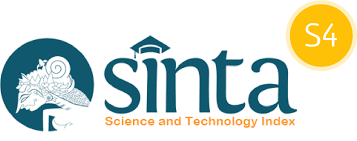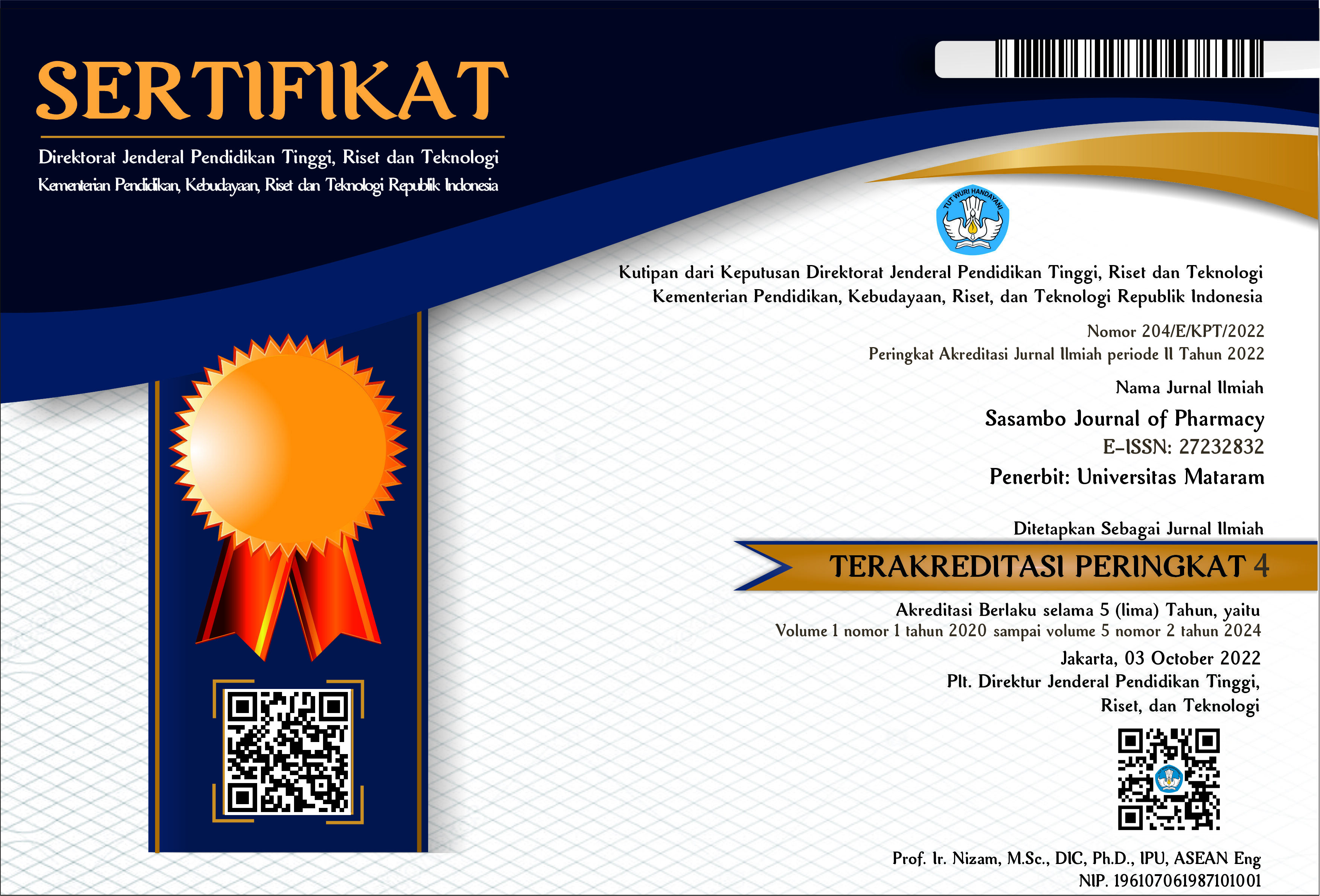Post-harvest process influences antibacterial activity of Clitoria ternatea flower extracts against Staphylococcus aureus and Escherichia coli
DOI:
10.29303/sjp.v6i1.451Downloads
Abstract
Butterfly pea is a plant with high potential for development as an antimicrobial agent. However, its antimicrobial potential is closely related to its phytochemical profile, which can be influenced by post-harvest processing. This study aimed to evaluate the effect of post-harvest processing on the antibacterial activity of butterfly pea flowers. Butterfly pea flower was prepared using three different methods: fresh, aerobic fermentation, and sun-dried. The samples were extracted by maceration using 96% methanol for 1 day with 3 re-extraction process. Phytochemical screening was conducted using colorimetric method with specific reagents for certain groups. Antimicrobial potential was tested using the well diffusion method on NA media in five different concentrations of extract. Extraction results showed that the three samples produced different extract yields, with sun-dried butterfly pea flower extract giving the highest yield (18%), followed by fresh extract (8%), and aerobic fermentation (0.8%). Phytochemical screening revealed that all three butterfly pea flower samples did not contain quinones and saponins. Additionally, alkaloids were not detected in the fermented extract. Antibacterial activity of the three butterfly pea flower extracts showed significantly different zone of inhibition, with the sun-dried extract consistently providing the largest zone of inhibition compared to fresh and fermented extracts against Escherichia coli and Staphylococcus aureus, with average inhibition zones of 8.67 - 11.17 ± 0.88 mm and 4.25 - 10.5 ± 1.64 mm, respectively. It can be concluded that the post-harvest processing affects the antibacterial activity of butterfly pea flowers.
Keywords:
Butterfly pea flower, Post-harvest processing, Antibacterial activityReferences
Ayu, D. S., Pratama, H. A., Sari, N. P., Febrianti, N., Komalasari, N. R., Adelia, P., Sari, R. P., Cahya, S. N., Panorama, S., Aminah, S., & Setiawansyah, A. (2024). Perbandingan uji mukolitik ekstrak dan fraksi daun lamtoro (Leucaena leucocephala (Lam) de Wit) halus dan kasar secara in vitro. Jurnal Ilmiah Sain Dan Teknologi, 2(4), 12–20. https://doi.org/10.572349/scientica.v2i4.1154.
de Nijs, M., Mulder, P. P. J., Klijnstra, M. D., Driehuis, F., & Hoogenboom, R. L. A. P. (2017). Fate of pyrrolizidine alkaloids during processing of milk of cows treated with ragwort. Food Additives and Contaminants - Part A Chemistry, Analysis, Control, Exposure and Risk Assessment, 34(12), 2212–2219. https://doi.org/10.1080/19440049.2017.1364432.
El-Gamal, R., Song, C., Rayan, A.M., Liu, C., Al-Rejaie, S., & ElMasry, G. (2023). Thermal Degradation of Bioactive Compounds during Drying Process of Horticultural and Agronomic Products: A Comprehensive Overview. Agronomy, 13, 1580. https://doi.org/10.3390/agronomy13061580
Febrianti, F., Widyasanti, A., & Nurhasanah, S. (2022). Aktivitas Antibakteri Ekstrak Bunga Telang (Clitoria ternatea L.) terhadap Bakteri Patogen. ALCHEMY Jurnal Penelitian Kimia, 18(2), 234. https://doi.org/10.20961/alchemy.18.2.52508.234-241
Fitriyah, F. & Ramadhani, A. N. (2024). Phytoestrogen Activity of Alkaloid Compounds of Butterfly Pea (Clitoria ternatea) Using In Silico Analysis. El-Hayah: Jurnal Biologi, 9(4), 133-138. https://doi.org/10.18860/elha.v9i4.24210.
Herlina, S., Setiawansyah, A., & Hidayati, N. (2024). Aerobe Fermentation Enhanced Antioxidant Activity Index of Citrus limon Leaves. Journal of Food and Pharmaceutical Sciences, 12(2), 80-89. https://doi.org/10.22146/jfps.12005.
Horablaga, N. M., Cozma, A., Alexa, E., Obistioiu, D., Cocan, I., Poiana, M. A., Lalescu, D., Pop, G., Imbrea, I. M., & Buzna, C. (2023). Influence of Sample Preparation/Extraction Method on the Phytochemical Profile and Antimicrobial Activities of 12 Commonly Consumed Medicinal Plants in Romania. Applied Sciences, 13(4), 2530. https://doi.org/10.3390/app13042530
Jamil, N., Mohd Zairi, M. N., Mohd Nasim, N. A., & Pa’ee, F. (2018). Influences of Environmental Conditions to Phytoconstituents in Clitoria ternatea (Butterfly Pea Flower) – A Review. Journal of Science and Technology, 10(2), 208-228. https://doi.org/10.30880/jst.2018.10.02.029
Khumairoh, L., Susilo, J., & Vifta, R. L. (2020). Perbedaan Pelarut Etanol 96% Dan Etil Asetat Pada Uji Aktivitas Antibakteri Ekstrak Bunga Telang (Clitoria ternatea L) Terhadap Propionibacterium acnes. Artikel Ilmiah. Program Studi Farmasi, Fakultas Kesehatan, Universitas Ngudi Waluyo.
Manjula, P., Mohan, Ch. M., Sreekanth, D. V, Keerthi, B., & Devi, B. P. (2013). Phytochemical analysis of Clitoria ternatea Linn., a valuable medicinal plant. The Journal of Indian Botanical Society, 92, 173–178. https://api.semanticscholar.org/CorpusID:185943484
MarÃn-Sáez, J., Romero-González, R., & Garrido Frenich, A. (2019). Effect of tea making and boiling processes on the degradation of tropane alkaloids in tea and pasta samples contaminated with Solanaceae seeds and coca leaf. Food Chemistry, 287, 265–272. https://doi.org/10.1016/j.foodchem.2019.02.091.
Marpaung, A. M. (2020). Tinjauan manfaat bunga telang (Clitoria ternatea l.) bagi kesehatan manusia. Journal of Functional Food and Nutraceutical, 1(2), 63–85. https://doi.org/10.33555/jffn.v1i2.30
Mphahlele, R. R., Fawole, O. A., Makunga, N. P., & Opara, U. L. (2016). Effect of drying on the bioactive compounds, antioxidant, antibacterial and antityrosinase activities of pomegranate peel. BMC Complementary and Alternative Medicine, 16(1). https://doi.org/10.1186/s12906-016-1132-y
Othman, L., Sleiman, A., & Abdel-Massih, R. M. (2019). Antimicrobial activity of polyphenols and alkaloids in middle eastern plants. Frontiers in Microbiology, 10(5), 911. https://doi.org/10.3389/fmicb.2019.00911
Oguis, G. K., Gilding, E. K., Jackson, M. A., & Craik, D. J. (2019). Butterfly pea (Clitoria ternatea), a cyclotide-bearing plant with applications in agriculture and medicine. Frontiers in Plant Science, 10, 645. https://doi.org/10.3389/fpls.2019.00645.
Riyanto, E. F., Nurjanah, A. N., Ismi, S. N., & Suhartati, R. (2019). Daya Hambat Ekstrak Etanol Bunga Telang (Clitoria ternatea L) Terhadap Bakteri Perusak Pangan. Jurnal Kesehatan Bakti Tunas Husada: Jurnal Ilmu Ilmu Keperawatan, Analis Kesehatan Dan Farmasi, 19(2), 218–225.
Sulaiman, M., Jannat, K., Nissapatorn, V., Rahmatullah, M., Paul, A. K., de Lourdes Pereira, M., Rajagopal, M., Suleiman, M., Butler, M. S., Break, M. K. B., Weber, J. F., Wilairatana, P., & Wiart, C. (2022). Antibacterial and Antifungal Alkaloids from Asian Angiosperms: Distribution, Mechanisms of Action, Structure-Activity, and Clinical Potentials. Antibiotics, 11(9), 1146. https://doi.org/10.3390/antibiotics11091146.
Thirumdas, R. & Annapure, U. S. (2020). Enzyme inactivation in model systems and food matrixes by cold plasma. In Advances in Cold Plasma Applications for Food Safety and Preservation. Elsevier Inc. pp, 229-252.
Utami, N., Susianti, S., Bakri, S., Kurniawan, B., & Setiawansyah, A. (2023). Cytotoxic activity of Cyperus rotundus L. rhizome collected from three ecological zones in Lampung-Indonesia against HeLa cervical cancer cell. Journal of Applied Pharmaceutical Science, 13(10), 141-148. https://doi.org/10.7324/japs.2023.113764
Wirasisya, D. G., & Hohmann, J. (2023). An overview of the traditional use, phytochemistry, and biological activity of the genus Homalanthus. Fitoterapia, 166, 105466. https://doi.org/10.1016/j.fitote.2023.105466.
Wirasisya, D., Juliantoni, Y., & Hajrin, W. (2018). Pengaruh Dua Metode Pengeringan Pada Aktivitas Antibakteri Ashitaba (Angelica keiskei) Terhadap Streptococcus mutans. Jurnal Farmasi Galenika, 4(1), 18–25. https://doi.org/10.22487/j24428744
Yan, Y., Li, X., Zhang, C., Lv, L., Gao, B., & Li, M. (2021). Research Progress on Antibacterial Activities and Mechanisms of Natural Alkaloids: A Review. Antibiotics (Basel, Switzerland), 10(3), 318. https://doi.org/10.3390/antibiotics10030318.
License
Copyright (c) 2025 The Author(s)

This work is licensed under a Creative Commons Attribution 4.0 International License.
Authors who publish with Sasambo Journal of Pharmacy (SJP), agree to the following terms:
- Authors retain copyright and grant the journal right of first publication with the work simultaneously licensed under a Lisensi Creative Commons Atribusi 4.0 Internasional. This license allows authors to use all articles, data sets, graphics and appendices in data mining applications, search engines, web sites, blogs, and other platforms by providing an appropriate reference. The journal allows the author(s) to hold the copyright without restrictions and will retain publishing rights without restrictions.
- Authors are able to enter into separate, additional contractual arrangements for the non-exclusive distribution of the journal's published version of the work (e.g., post it to an institutional repository or publish it in a book), with an acknowledgment of its initial publication in Sasambo Journal of Pharmacy
- Authors are permitted and encouraged to post their work online (e.g., in institutional repositories or on their website) prior to and during the submission process, as it can lead to productive exchanges, as well as earlier and greater citation of published work (See The Effect of Open Access).







